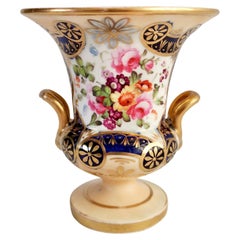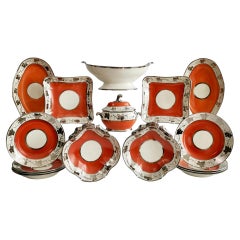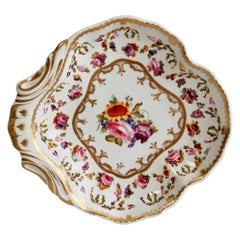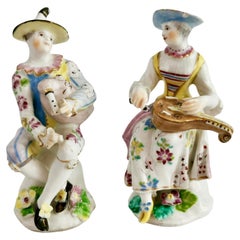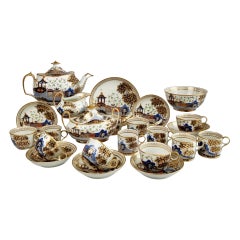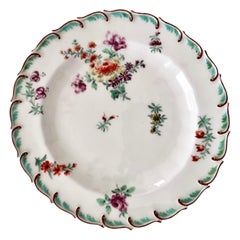Willa Latham
to
4
97
59
40
40
31
27
26
18
15
13
12
11
10
10
9
9
6
6
3
3
3
2
2
1
1
1
17
11
11
9
6
Staffordshire Porcelain Campana Vase, Salmon, Gilt and Flowers, circa 1820
By Staffordshire
Located in London, GB
On offer is a very fine small porcelain campana vase made circa year 1820 by an unknown Staffordshire potter. The vase has a beautiful delicate salmon colored ground, rich gilding an...
Category
Antique 1820s English Regency Vases
Materials
Porcelain
Coalport John Rose Pearlware Dessert Service, Orange with Silver Vines, ca 1800
By Coalport Porcelain, John Rose
Located in London, GB
This is a stunning and extremely rare dessert service made by John Rose at Coalport probably around the year 1800, shortly after Rose bought up the Caughley factory. It consists of a large centre piece comport, one sauce tureen with cover, two oval dishes, two square dishes, two shell dishes, and eight plates. The service is beautifully decorated in the Neoclassical style.
Coalport was one of the leading potters in 19th and 20th Century Staffordshire. They worked alongside other great potters such as Spode, Davenport and Minton, and came out with many innovative designs. When we say "Coalport" we usually think of the one Coalport factory that became famous, but in its beginning years there were two factories, one run by John Rose and the other by his brother Thomas Rose. Thomas Rose went into partnership with Robert Anstice and Robert Horton and they were located directly opposite John Rose, across the canal. John Rose had bought up the local Caughley factory in 1799. The brothers' factories had much in common with each other and they shared many different shapes and patterns. Ultimately, the John Rose factory proved more profitable and John Rose bought Thomas' factory in 1814, making it the one Coalport factory that became so famous. Many of the Coalport items, of either factory, are now collectors' items.
This service is made of pearlware, which leads us to believe that it might have been made at the old Caughley premises, which had kilns for pearlware - the later Coalport items are not known to be made of pearlware but the shape of the dishes and the sauce comport are clearly a Coalport shape.
All items have a beautiful deep orange ground - they were done in different firings as the colour is not entirely consistent, which makes the service very charming. The rims are set off with a beautiful vine pattern in silver, which makes the service even more rare as this was not done often.
The items are unmarked, as is usual for that era, except the odd "B", which is probably the gilder's tally mark.
CONDITION REPORT The service is in good usable condition with some minor flaws: there is some crazing and wear throughout, which is to be expected of pearlware of this era. The centre piece comport has a slight crack through the side, which is not very visible. One of the plates has a chip on the front of the rim as well as three lines coming off the rim; one has a chip on the underside of the rim; and one has a line coming off the rim. Neither of these stand out and the plates are entirely stable.
Antique British china...
Category
Antique Early 1800s British Neoclassical Dinner Plates
Materials
Pearlware
Bloor Derby Shell Dish, White, Floral Sprigs Moses Webster, Regency, 1820-1825
By Bloor Derby
Located in London, GB
This is a beautiful one-handled dessert serving dish or "shell" dish made by Derby between about 1820 and 1825 in the Regency era and decorated by Moses Webster. These dishes were to...
Category
Antique 1820s English Regency Serving Bowls
Materials
Porcelain
Bow Pair of Porcelain Figures, Arlecchino and Columbina, Rococo ca 1758
By Bow Porcelain
Located in London, GB
This is a wonderful pair of figures of Arlecchino and Columbina, made by the Bow Porcelain factory in about 1758. These figures formed part of a series of the Commedia dell'Arte, a very popular series of theatrical figures that served as decoration at the dinner table in the 18th Century.
The Bow Porcelain Factory was one of the first potteries in Britain to make soft paste porcelain, and most probably the very first to use bone ash, which later got perfected by Josiah Spode to what is now the universally used "bone china". Bow was the main competitor of the Chelsea Porcelain Factory, but where Chelsea made very fine slipcast porcelain, Bow made a different soft paste porcelain that tended to be softer and could be pressed into moulds. Bow served a larger public generally at lower prices. The factory was only in operation between 1743 and 1774, after which the tradition got incorporated into some of the later famous potteries such as Worcester and Derby.
These figures were used to adorn the dinner table when dessert was served; groups of figures served to express something about the host, the guests, or to direct the conversation. The Italian Commedia Dell'Arte, a comical form of masked theatre, was very popular in those days and Bow copied many figures of the German Meissen series that were brought out in the decades before.
This pair dates from about 1758, which was at the height of Bow's ability to make beautiful figurines often copied from Chelsea or Meissen. The pair is modelled after a Meissen pair by Kaendler. The porcelain is translucent with a beautiful milky glaze - Bow was probably the first pottery using bone in its porcelain recipe. Arlecchino (Harlequin) is playing the bagpipes, dressed in an odd costume of mismatched chintz and playing cards and wearing a funny black trumpet...
Category
Antique 1750s English Rococo Figurative Sculptures
Materials
Porcelain
New Hall Tea Service for Four, Elephant Pattern 876, Regency ca 1810
By New Hall
Located in London, GB
PLEASE NOTE THE NUMBER OF TRIOS IN THIS SERVICE HAS BEEN REDUCED FROM SIX TO FOUR, AND THE PRICE HAS BEEN REDUCED ACCORDINGLY. IT NOW IS AN 18-PIECE SERVICE.
This is spectacular full tea service for four made by New Hall around the year 1810. The service consists of a teapot with cover, a sucrier with cover, a milk jug, four trios each consisting of a teacup, a coffee can and a saucer, a cake plate (saucer dish) and a slop bowl. The set is decorated in the super-charming and popular but very rare Elephant pattern...
Category
Antique 1810s English Regency Tea Sets
Materials
Porcelain
Chelsea Plate, Feather Moulded with Flowers, Red Anchor Mark, ca 1755
By Chelsea Porcelain
Located in London, GB
This is a beautiful plate made by Chelsea in circa 1755, which is known as the "Red Anchor" period of the factory.
Chelsea was one of the very early adopters of porcelain in the British china industry. Founded in 1744 the Chelsea pottery was for about 40 years the leading maker of fine chinaware, excelling in their sense of style, perfection and constant innovation and inspiring many following generations of china makers.
The company was started by French silversmith Nicholas Sprimont and you can see the influence of the French style of silverware...
Category
Antique 1750s English George II Dinner Plates
Materials
Porcelain
Belleek Cabaret Tea Set, Cream Cob Lustre, Erne, Victorian, 1890s
By Belleek Pottery Ltd.
Located in London, GB
This is an extremely rare Belleek cabaret set for two, or "tête-à-tête", made in the Erne series brought out in the 1890s. The items carry the 2nd Black Mark, used between 1891 and 1926. The set consists of a teapot, a milk jug, a sugar bowl, two teacups and saucers, and a large matching tray.
This set is very fine and with its restrained cream-white colour it would make a wonderful wedding gift!
If you ever thought Belleek fine china looks, sounds and feels unique, you are right. There is a back story to this extraordinarily fine Irish eggshell porcelain, which has an unusually high amount of "frit" and therefore is thinner and finer than any other china.
Pottery in Belleek (in the now Northern-Irish area of Fermanagh) had started in 1849 with John Caldwell Bloomfield, who was a wealthy land owner. During the Irish famine he realised that unless he would find a way for his tenants to make a profit off the land, they would starve. Agriculture had become impossible due to the agricultural diseases. This caused millions to starve and more millions to leave. As an amateur mineralogist, John Caldwell Bloomfield realised that his land had exactly the right mineral deposits to be used as clay for porcelain. He involved several investors and scientists and after many years of research, trial, error, the building of a railway line to import coal from England, and building a factory, the Belleek pottery resulted, employing the local people and soon producing the finest china made with clay from the Belleek area.
What had started as a way to fend off famine among the local tenants had became a story of incredible success by the 1880s as Queen Victoria fell in love with the fine white china and the many homely, slightly bizarre but nature-loving designs; this was different from English tradition, yet it was very much to the taste of the British who had developed a real love for home-made fine china since it was introduced in the late 18th Century. Belleek not only brought out many tea services, but started a new tradition of intricately woven porcelain baskets. Soon the English nobility started to place big orders and the pottery is still flourishing today and selling its wares the world over, while in England most potteries have long disappeared.
Belleek made many cabaret services, often called breakfast services or "tête-à-tête" services; these were used to carry breakfast tea up to the bedroom. Queen Victoria bought one in the Echinus style during a visit to the factory in the 1860s, and ever since Belleek's cabaret services have been in great demand. Nowadays there are very few of these left and it is rare to find a full service like this.
The Erne series was named after the river right besides the Belleek factory. This river forms the border between the Republic of Ireland and Northern Ireland, with the factory on the Northern Irish end of the bridge at Belleek. The pattern seems to be a play on the baskets and nets of the fishermen who once fished the abundant trout and salmon on the river Erne and the lake that belongs to it.
The items carry the second Black Mark, which was used between 1891 and 1926, however the very fine quality of the porcelain indicates that most pieces of the set are more likely to be from the 1890s than from the 20th Century. You will see that the shade of cob lustre is different on each item; this is normal for Belleek tea sets...
Category
Antique Late 19th Century Northern Irish Victorian Tea Sets
Materials
Porcelain
Spode Porcelain Teacup Trio, Red Imari Dollar Pattern, Regency, ca 1810
By Spode
Located in London, GB
This is a beautiful orphaned teacup made by Spode in about 1810. It bears a lavish Japanese-inspired Imari pattern.
Spode was the great pioneer among the Georgian potters in England. Around the year 1800 he perfected the bone china recipe that has been used by British potters ever since, and he was also the leading potter behind the technique of transferware, making it possible for English potters to replace the Chinese export china, which had come to an end around that time, with their own designs. This was fundamental to a thriving industry that would last for about 150 years and provide half the world with their tableware. Spode porcelain is regarded as one of the highest quality porcelains around; for a soft-paste porcelain it is surprisingly hard and fine, and has a wonderful bright white colour.
The pattern on this can is called "Dollar" pattern, a very famous pattern that was used by English potters in the 18th and early 19th Century. It is obvious why it is called “dollar” - but its origin is less obvious! It is thought that this pattern was derived from a very old Chinese pattern depicting a tree with elaborate foliage that hides a Chinese character representing longevity or happiness. Traditionally, this went with a an image called “Taotie”, which was used on very ancient bronze vases...
Category
Antique Early 1800s English Regency Porcelain
Materials
Porcelain
Chamberlains Worcester Porcelain Dish, Nelson or Fine Old Japan pattern, ca 1805
By Chamberlains Worcester
Located in London, GB
This is a striking square serving dish made by Chamberlains in Worcester around 1805. The dish bears the Fine Old Japan pattern, often called the Nelson pattern.
Robert Chamberlai...
Category
Antique Early 1800s English Georgian Serving Bowls
Materials
Porcelain
Coalport Pair of Floral Gilded Sauce Tureens, Marquess of Anglesey, circa 1820
By Coalport Porcelain
Located in London, GB
This is an extremely rare set of lidded sauce tureens made by Coalport in circa 1820. The tureens are decorated in the "Marquess of Anglesey" pattern. These sauce tureens would have formed part of a large dessert service. They were used for the sauce to be served on ice cream or a cooked sweet dish, and the lids have holes for the sauce ladles.
Coalport was one of the leading potters in 19th and 20th century, coming out with many innovative designs. The pottery emerged around the year 1800 in Shropshire, right on the edge of Staffordshire and near other great makers such as Spode, Minton, Davenport and many others. They went on to become a major potter in the 19th century and brought out many iconic designs.
The Welsh Nantgarw factory first created the heavily gilded service for the Marquess of Anglesey, with beautifully painted flowers. Later the Swansea factory made additions to or copies of this service, and circa 1820 Coalport...
Category
Antique 1820s English Regency Porcelain
Materials
Porcelain
H&R Daniel Pair of Potpourri Vases, Maroon, Birds, Flowers, Rococo Revival c1840
By H&R Daniel
Located in London, GB
On offer is a stunning pair of potpourri vases with covers made by H&R Daniel in about 1840. The vases are in the Rococo Revival style, and have a deep maroon ground and reserves wit...
Category
Antique 1840s English Rococo Revival Vases
Materials
Porcelain
George Jones Majolica Fish Tureen, Mackerel, Victorian ca 1875
By George Jones
Located in London, GB
This is a stunning fish tureen with cover made by George Jones in about 1875. The piece is made of majolica in the shape of a basket with a mackerel on the...
Category
Antique 1870s English Victorian Platters and Serveware
Materials
Majolica
Royal Worcester Porcelain Potpourri Vase or Urn with Hadley Roses, 1923
By Royal Worcester
Located in London, GB
This is a very fine small potpourri vase and cover made by Royal Worcester in 1923. The urn has a blush ivory ground with exceptionally beautiful hand painted Hadley roses.
Potpourr...
Category
Vintage 1920s English Edwardian Urns
Materials
Porcelain
Minton Majolica Game Pie Tureen, Rabbit, Mallard and Dove, Victorian 1881
By Minton
Located in London, GB
This is a stunning game pie tureen with cover made by Minton in 1881. The piece is made of majolica and has realistically relief-moulded game on the cover: a rabbit, a mallard and a ...
Category
Antique 1880s English Victorian Platters and Serveware
Materials
Majolica
Bow Porcelain Figure of Boy Putto on C-Scroll Base, Georgian circa 1760
By Bow Porcelain
Located in London, GB
This is a wonderful little figure of a boy or putto made by the Bow Porcelain factory in about 1760.
The Bow Porcelain Factory was one of the first potteries in Britain to make soft...
Category
Antique 1760s English Rococo Figurative Sculptures
Materials
Porcelain
Derby Figure of Shepherdess with Garlanded Lamb, ca 1760
By Derby
Located in London, GB
This is a charming Derby figure of a shepherdess with a garlanded lamb, made in or shortly after 1760. The figure is one half of a set called the "Garland...
Category
Antique 1760s English Rococo Figurative Sculptures
Materials
Porcelain
Worcester Pierced Porcelain Basket, Blue Scale Japanese Kakiemon, circa 1765
By 1st Period Worcester Dr. Wall
Located in London, GB
This is a rare and beautiful porcelain basket made by Worcester circa 1765 in their 1st or "Dr Wall" period. These baskets were used for dinners or desserts to serve fruit or bread. The basket is decorated in the famous "blue scale" ground with very fine Japanese Kakiemon...
Category
Antique 1760s English George III Decorative Baskets
Materials
Porcelain
French Porcelain Serving Dish, Heron and Cockerel La Fontaine, circa 1820
Located in London, GB
This is a incredibly charming shell-shaped serving dish made by an unknown maker in France in circa 1820. The dish is modelled in the Sèvres style and decorated with hand painted sce...
Category
Antique 1820s French Regency Platters and Serveware
Materials
Porcelain
Crown Derby Porcelain Plate, Puce Cherubs by Richard Askew, Georgian ca 1785
By Crown Derby
Located in London, GB
This is a beautiful Crown Derby plate made in about 1785. The very charming decoration of a puce putto is by Richard Askew.
The Derby Porcelain factory has its roots in the late 174...
Category
Antique 1780s English Georgian Dinner Plates
Materials
Porcelain
Samuel Alcock Plate, Inverted Shell, Flowers, Provenance G.A.Godden Regency 1822
By Samuel Alcock & Co.
Located in London, GB
This is a very striking and rare square dessert serving dish made by Samuel Alcock, circa 1822. The dish has a hand painted flower landscape in an unusual style. The dish has provena...
Category
Antique 1820s English Regency Platters and Serveware
Materials
Porcelain
